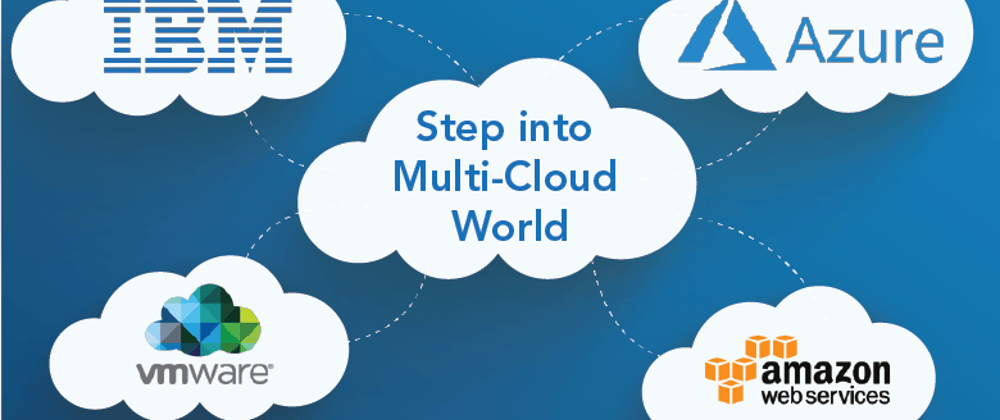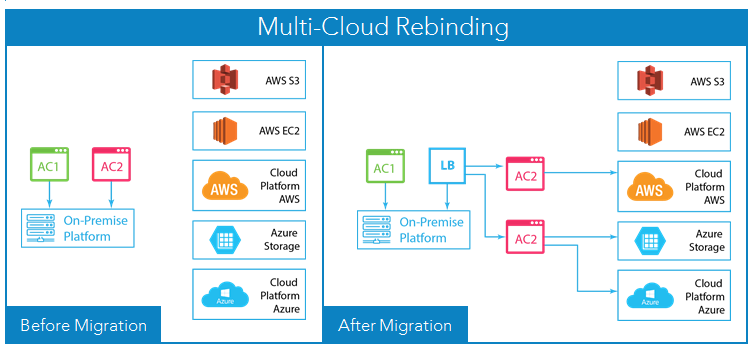Multi-cloud is the next big thing today that is offering businesses the capability to experience multiple cloud services and build the best infrastructure. Companies now do not need to move between platforms because with a multi-cloud adoption strategy you can bring many technologies together such as AWS, Azure, VMware and more in one system to efficiently meet their business goals. One of the prime reasons why enterprises prefer this approach is to avoid depending on just one cloud vendor for all their cloud-related needs.
“81% of enterprises have a multi-cloud strategy”
– 2018 State of the Cloud Survey, RightScale
There are many types of multi-cloud architectures including re-deployment, cloudification, relocation, refactoring, rebinding, replacement, and modernization for organizations to adopt.
Multi-cloud rebinding
A multi-cloud rebinding is an architecture that is used to route users to the nearest data center when your primary cloud or on-premises data center fails. Basically, this architecture can configure and monitor the status of the service to which they are directing the users, and if the service is not available, it helps to route traffic to another resource.
Let’s see how an application is deployed in a multi-cloud setting:
Figure 1: Multi-cloud rebinding architecture diagram
In this architecture diagram, a re-architected application is deployed partially on multiple cloud environments. Here, AC1 and AC2 are two application components hosted on-premises before migration. As both the components are independent integrity units, AC1 remains on-premises while two AC2s are deployed on AWS and Azure for disaster recovery.
Benefits of adopting a multi-cloud solution
1. Ability to mix different delivery models
Multi-cloud allows you to choose from a growing range of services to create a customized solution that best suits your organization. You gain the ability to use mixed delivery models including SaaS (Software-as-a-Service), PaaS (Platform-as-a-Service), and IaaS (Infrastructure-as-a-Service). As well as increase the capability for each existing and new applications and make the decision that best suits your business goals. You can use a combination of platforms including Amazon Web Services (AWS), Azure, Google Cloud Platform, VMware and more. This multi-cloud architecture becomes your base for new business capabilities and functions.
2. Making data management flexible
Many organizations require using different types of data depending on their industry. Multi-cloud can be the best fit for such organization as they require storing data in particular type of cloud while running other workloads in another cloud. When you manage data on multiple clouds, you can be confident that your data will remain available and secure even if one of the cloud hosts fail. For example, an e-commerce business may require hosting data on multiple cloud platforms that best supports digital media such as images, videos, animation, graphics, and more.
Multi-cloud also offers low latency and allows quick data transfer across different platforms, and manages your workloads and services, as it utilizes more than one cloud services, ensuring that your enterprise serves customers without any inconvenience.
Cloud strategy and assessment workshop
The adoption of cloud-based infrastructure by enterprises is increasing greatly. However, a lot of enterprises are still reluctant to adopt a cloud strategy due to lack of skills or knowledge.
3. Avoiding single vendor lock-in
Initially, single cloud vendors led enterprises for a lock-in period that often results in limited flexibility, prolonged proof of concepts, delayed decisions, and costlier outcomes. Such issues would further result in slowing down the business operations and overall fail the organization to meet their business-changing needs timely.
Multi-cloud deployment allows you to get full control over your systems including the power to switch your cloud platforms easily. When you use a mix of private and public cloud platforms, you will be able to match your system needs to your business solutions. With multi-cloud, you can scale down your cloud services to the local server whenever desired and without causing disruptions to your business operations. Such ability will reduce dependency over a single vendor and open the doors to negotiation for favorable agreements.
4. Optimizing cost-effective outcomes
The traditional delivery methods of cloud platform and the scaling efficiencies of multiple cloud services can always be compared. With multi-cloud strategy, you can use your own apps anytime into the cloud and build greater resiliency at a lower price than the previous redundancies would have costed you. You can easily share your workloads across multiple cloud platforms and reduce downtime simultaneously.
Multi-cloud proves to be a cost-effective solution, as enterprises get to analyze and reduce capital expenses related to hardware, server, and systems that have an impact on their business performance and productivity. In short, the multi-cloud solution enables you to scale cloud services at dropping costs – without disrupting your business operations.
5. Added security with multi-cloud
Multi-cloud allows a combination of a private or public cloud platform. For added security, it is advisable that you secure your data in the private cloud while operating other areas of the business using a public or hybrid cloud environment.
Using a multi-cloud architecture will also help you a lower risk of a DDoS (distributed denial-of-service) attack by providing a level of resiliency, which is not possible with a single provider. A DDoS attack is a serious result of several computer systems attacking a server, a website, a network resource or even a cloud hosting. These attacks can be conducted by anyone, including a hacker or even hostile foreign power. For instance, if in case your primary cloud suffers an attack, your workloads can be immediately shifted to other cloud environments.
Insight
All types of cloud are developing, be it public, private or hybrid; therefore huge enterprises can openly embrace multi-cloud service management to meet their divisional operations. Reap many benefits while keeping challenges and risks to a minimum level by adopting a multi-cloud strategy. We are confident that multi-cloud is here to stay and enterprises should adopt it without giving a second thought. Get in touch with our consultant and learn how you can get started.








Top comments (0)